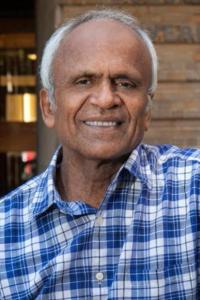Sekhar Ramakrishnan, EngScD
- Senior Research Scientist in the Department of Pediatrics
On the web

Overview
Sekhar Ramakrishnan, EngScD is a Senior Research Scientist in the Department of Pediatrics. He manages a clinical research elective, taken by nearly all second-year pediatrics residents, to help them finalize their resident research project proposals from the viewpoint of power analysis, and also to teach them statistical tools to help them be self-sufficient. He also teaches in a Master of Science program at the Institute of Human Nutrition at the medical center.
Academic Appointments
- Senior Research Scientist in the Department of Pediatrics
Credentials & Experience
Education & Training
- 1968 Indian Institute of Technology (India)
- MS, 1971 Columbia University, NY
- ScD, 1975 Columbia University, NY
Honors & Awards
- Berman-Zech Award Lecture
- KinMet Satellite Symposium of ATVB, 2009
Research
Sekhar Ramakrishnan's research activities are in applying biostatistics and biomathematics to clinical research projects inside and outside the Department of Pediatrics.
Grants
I am a co-investigator on all of the following NIH/HRSA-funded projects:
- 2016-2021 UL1
“Clinical and Translational Science Award”
PI: MP Reilly - 2017-2023 R35
“Phenotyping Genetic Disorders of Hepatic Lipid and Lipoprotein Metabolism in Cells, Mice, and Men”
PI: HN Ginsberg - 2014-2018 R01
“PRISM: Personalized Reminders for Immunization using Short Messaging systems”
PI: M Stockwell - 2015-2018 R01
“SINC: Synchronized Immunization Notifications”
PI: M Stockwell - 2015-2020 R01
“Omega-3 Fatty Acids Acute Neuroprotection via Mitochondria”
PI: RJ Deckelbaum - 2015-2020 R01
“Postprandial Vitamin A”
PI: WS Blaner
Selected Publications
- Reyes-Soffer G, Ginsberg HN, Ramakrishnan R. The metabolism of lipoprotein(a): an ever-evolving story. J Lipid Res. 58:1756-64, 2017. PMID: 28720561
- Ginsberg HN, Ramakrishnan R. Investigations of apoCIII metabolism using stable isotopes: what information can you acquire and how can you interpret your results? J Lipid Res. 52:1071-2, 2011. PMC3090228
- Ramakrishnan R, Ramakrishnan JD. A state space transformation can yield identifiable models for tracer kinetic studies with enrichment data. Bulletin of Mathematical Biology. 72:2019-46, 2010. PMC3275642
- Ramakrishnan R, Ramakrishnan JD. Utilizing Mass Measurements in Tracer Studies - A Systematic Approach to Efficient Modeling. Metabolism.57:1078-87, 2008. PMC2601710
- Rubin J, Kim HJ, Pearson TA, Holleran S, Berglund L, Ramakrishnan R. The apolipoprotein(a) gene: Linkage disequilibria at three loci differs in African Americans and Caucasians. Atherosclerosis.201:138-47, 2008. PMC2784197
- Ginsberg HN, Ramakrishnan R. Kinetic studies of the metabolism of rapidly exchangeable apolipoproteins may leave investigators and readers with exchangeable results. Arterioscler Thromb Vasc Biol. 28:1685-6, 2008. PMC3275632
- Ramakrishnan R. Alternative equations for whole-body protein synthesis and for fractional synthetic rates of proteins. Metabolism. 56:1550-60, 2007. PMC2435311
- Ramakrishnan R. Studying apolipoprotein turnover with stable isotope tracers - correct analysis is by modeling enrichments. J Lipid Res.47:2738-53, 2006. PMC3276318
- Sloan RP, Ramakrishnan R. Science, medicine, and intercessory prayer. Perspect Biol Med. 49:504-14, 2006. PMID: PMC3275584
- Sloan RP, Ramakrishnan R. The MANTRA II study. Lancet 366:1769-70, 2005. PMID: 16298208
- Berglund L, Ramakrishnan R. Lipoprotein(a): an elusive cardiovascular risk factor. Arterioscler Thromb Vasc Biol. 24:2219-26, 2004. PMID: 15345512
- Dell RB, Holleran S, Ramakrishnan R. Sample size determination. ILAR J. 43:207-13, 2002. PMID: 12391396
- Kashyap S, Sahni R, Ramakrishnan R. Following up randomized feeding studies - a way to test the fetal programming hypothesis. Pediatr Res. 50(2 Pt 2):13A, 2001.(Presented at the First World Congress on Fetal Origins of Adult Diseases, Bombay, Feb 2001)
- Berglund L, Witztum JL, GaleanoNF, KhouwAS, Ginsberg HN, Ramakrishnan R. Three-fold effect of lovastatin treatment on low density lipoprotein metabolism in subjects with hyperlipidemia: increase in receptor activity, decrease in apoB production, and decrease in particle affinity for the receptor. Results from a novel triple-tracer approach. J Lipid Res. 39:913-24, 1998. PMC3988111
- Ginsberg HN, Karmally W, Siddiqui M, Holleran S, Tall AR, Rumsey SC, Deckelbaum RJ, Blaner WS, Ramakrishnan R. A dose-response study of the effects of dietary cholesterol on fasting and postprandial lipid and lipoprotein metabolism in healthy young men. ArteriosclerThromb. 14:576-86, 1994. PMID: 08148356
- Schulze K, Kashyap S, Ramakrishnan R. Cardiorespiratory costs of growth in low birth weight infants. J Dev Physiol. 19:85-90, 1993. PMID: 08409279
- Varma DR, Ramakrishnan R. Effects of protein-calorie malnutrition on transplacental kinetics of aminoisobutyric acid in rats. Placenta. 12:277-84, 1991. PMID: 01754576
- Ramakrishnan R, Arad Y, Wong S, Ginsberg HN. Nonuniform radiolabeling of VLDL apolipoprotein B: implications for the analysis of studies of the kinetics of the metabolism of lipoproteins containing apolipoprotein B. J Lipid Res. 31:1031-42, 1990. PMC3275143
- Ramakrishnan R, Leonard EF, Dell RB. A proof of the occupancy principle and the mean transit time theorem for compartmental models. Math Biosci. 68:121-136, 1984. doi: 10.1016/0025-5564(84)90076-2
- Goodman DS, Smith FR, Seplowitz AH, Ramakrishnan R, Dell RB. Prediction of the parameters of whole body cholesterol metabolism in humans. J Lipid Res. 21:699-713, 1980. PMID: 07419983
For a complete list of publications, please visit PubMed.gov